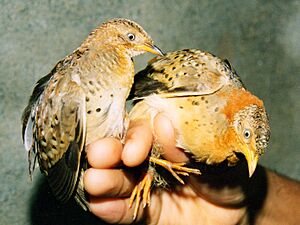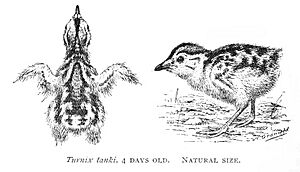Yellow-legged buttonquail facts for kids
Quick facts for kids Yellow-legged buttonquail |
|
|---|---|
 |
|
| Yellow-legged buttonquails. Maharashtra, India | |
| Conservation status | |
| Scientific classification | |
| Genus: |
Turnix
|
| Species: |
tanki
|
The yellow-legged buttonquail (Turnix tanki) is a small bird that looks a bit like a quail. However, it belongs to a different bird family called buttonquails. These birds are special because the females are usually bigger and more colorful than the males. Also, the females often have more than one male partner, which is quite unusual in the bird world!
Contents
About the Yellow-Legged Buttonquail
The yellow-legged buttonquail is a small bird. It grows to be about 15 to 18 cm (6 to 7 in) long. That's about the size of a small ruler! Female buttonquails are a little larger and have brighter colors than the males.
- Males of one type (Turnix t. tanki) weigh about 36 to 43 g (1.3 to 1.5 oz).
- Males of another type (Turnix t. blanfordii) weigh about 35 to 78 g (1.2 to 2.8 oz).
- Females of this type are heavier, weighing about 93 to 113 g (3.3 to 4.0 oz).
These birds have short tails and wings with rounded tips.
What Does a Male Look Like?
The adult male yellow-legged buttonquail has a black top of the head with light brown edges. Sometimes, there's a light brown stripe down the middle. The front and sides of its head are light brown with black tips on the feathers.
- Its throat is very light brown.
- This color gets darker, turning reddish-brown on its chest.
- It becomes lighter again on its belly, turning white near its tail.
- The sides of its chest have small, round black spots.
- Its back and tail are greyish-brown with reddish and dark brown patterns and spots.
- The main wing feathers are blackish-brown with light brown edges.
- Its beak is a dull yellow, its eyes are whitish, and its legs and feet are a bright yellow.
What Does a Female Look Like?
Adult females are more colorful than males. They have a wide, reddish-brown band around the back of their neck. The spots and patterns on their back and tail are not as dark. Their beak and legs are a brighter yellow, and their eyes are creamy white or yellowish-brown.
When they are not breeding, the female's reddish-brown neck band becomes mixed with grey. The rest of her feathers also look greyer. Young buttonquails look similar to the males but have duller feathers and less bright chest colors. They also have more fine speckles.
Where Do They Live?
The yellow-legged buttonquail lives only in certain parts of the world. You can find them in the Indian subcontinent, East Asia, and Southeast Asia.
There are two main types, called subspecies:
- T. t. tanki lives in Pakistan, India, Nepal, and the Andaman and Nicobar Islands.
- T. t. blanfordii lives in Myanmar, Indochina, and eastwards into eastern China.
These birds also travel to and breed in the Korea peninsula and the southernmost parts of southeast Russia. Most of the time, they stay in one place. However, some travel to drier parts of India during the wet season. They also migrate to southeastern Russia, flying at night.
How Do They Behave?
Yellow-legged buttonquails usually stay on the ground. If they sense danger, they prefer to run away rather than fly. You will often see them alone or in pairs.
What Do They Eat?
Their diet includes:
- Green plants
- Seeds
- Various insects like beetles, ants, and grasshoppers
Reproduction
Yellow-legged buttonquails usually breed between March and November, mostly during the wet season. Female birds have a bright reddish-brown band on their neck during breeding season, which they lose when it's not breeding time.
During courtship, females might offer food to males. Once the female lays her eggs, she leaves the male to take care of them. The male sits on the eggs to keep them warm (this is called incubation).
- The nest is a shallow dip in the ground, lined with grasses. It often has a roof made of bent plant stems, with an entrance on the side.
- A female usually lays four eggs, which are greyish-white with blotches.
- The male alone incubates the eggs. They hatch after about 12 to 16 days.
- After the chicks hatch, the male takes care of them. The baby chicks follow the male around.
- After laying her eggs, the female often goes off to find another male. She will then lay another set of eggs with him in a different nest.
Conservation Status
The yellow-legged buttonquail lives across a very large area and is quite common. The total number of these birds seems to be steady, and there are no big threats to them. Because of this, the International Union for Conservation of Nature says that the bird's conservation status is "least concern". This means they are not currently in danger of disappearing.



